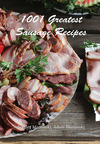Meats and Sausages
Fruit Butters
A fruit butter is a sweet spread made of fruit or a combination of fruits cooked to a paste. Technology of making fruit butters, unlike making jams and jellies, does not depend on a delicate balance of pectin – sugar – acid. This is why fruit butters take less sugar than jams, and can be made without any sugar. This is a huge advantage for people who stay away from sugar for medical reasons. Fruit butters can be sweetened with natural substitute Stevia or with artificial sugar substitutes. Pectin, whether natural, or commercial, is needed to gel jams, so fruits are carefully selected. Fruit butters are not dependent on pectin so any fruit is suitable. Fruit butters are made with ripe or overripe fruit, which might not be suitable for quality jam.
Their one drawback is that they require very long and careful cooking, because theystick to the pot and scorch. The product itself does not contain dairy butter, however, if done right, the newly made fruit butter or paste can have a texture similar to dairy butter. Because of its thick, soft butter-like texture fruit butters are used as spreads for breads. Fruit butters were always popular in European countries– Belgium, Netherlands, Germany, Czech Republic, Poland and Russia.
Fruit Preparation
- Prime mature or over-ripe fruit may be selected. Wash fruit, remove blossom ends, stems and cores. Fruits contain different amount of juice and also exhibit different degree of hardness so there is not one universal cooking time to soften them. Cut fruit into smaller pieces.
- Add ½ as much water (cider) as fruit for apples, quinces, crabapples and pears.
- Add ¼ as much water (cider) for apricots. Remove pits.
- Peaches, plums and grapes can be cooked in their own juice. Dip peaches in hot water, peel the skin and remove the pit.
Making the Pulp
- Cook the fruits until their pulp is soft.
- Strain through a colander, remove skins and pits. Press the pulp through a sieve.
Cooking
- Adding ½ cup of sugar to each 1 cup of fruit works for most fruits well. Plum butter is often made with less sugar.
- Cook the pulp over low fire until thicker. Stir often to prevent scorching. To prevent scorching and caramelization, add sugar at the later stage of cooking.
- When the butter is thick, test for doneness. If it does not pass the test, cook longer.
Filling Containers
Fill sterilized containers with hot butter, leaving ¼” headspace. Wipe jar rims and adjust lids. Process for 5 minutes in a boiling water bath.
Apple Butter
Typically seasoned with cinnamon, cloves and other spices, apple butter is usually spread on bread, used as a side dish, an ingredient in baked goods, or as a condiment. Apple butter is also mixed with vinegar while cooking to provide a small amount of tartness to the usually sweet apple butter. There a little difference between making apple sauce and apple butter, the butter being much denser.
Plum Butter
Plum butter is a preserve, which is served as bread spread or in baby food. This nota substitute for plum jam, plum butter is a product with its own character. Its flavor is strong and more acidic than jam and it is less sweet because it is made with a little sugar. Many people make plum butter without any sugar. For this reason plumbutter appeals to people who find jam too sweet, to those who are on diet or stay away from sugar for medical reasons or to those who prefer strong fruit flavor to sweetness.
It is an ideal material for cooking and baking purposes as it is low in sugar, firm in consistency and it does not sweat like a regular jam. Regular jams have a tendency to soften the pastry, but plum butter does not create such problems.
Plum butter is known under different names all over Europe and in the USA. It has been always a big hit in Poland (Powidla Sliwkowe) where it is added to pastry, mixed with chocolate or eaten with meat dishes or cold cuts.
Materials
Fresh plums, plum pulp, dry prunes or a combination of the two. Whether they are used together or separately is a matter of personal preference. Each of these choices will result in a product of a different taste, character and texture.
White or brown sugar, glucose and if desired, spices. Sugar (if used) is applied in small amount, usually at 10-20% in relation to the weight of the fruit pulp.
Storage
Fruit butters should be stored in well ventilated, cool and dark places. They have excellent keeping qualities, properly stored plum butter will retain its flavor for many years.
NOTE apple and plum are the best-known ingredients, but other fruits such as apricots, cherries, quinces, prunes, pears or cranberries also make good butters.
There is a little concern about color darkening as plum butter turns out very dark, anyhow.
For chocolate color add some caramel.
Fast Method
- A. Soak dry plums (prunes) for 12 hours.
- B. Blend prunes in a food processor.
- C. Add cinnamon and cook on low heat stirring often. After 30 minutes test for doneness.
- D. Pack in clean jars and process for 10 minutes in a boiling water canner.
Testing Fruit Butters for Doneness
- Place a small quantity of the butter on a plate. When a rim of the liquid does not separate around the edge of the butter, it is done.
- Remove a spoonful of the hot butter from the pan and hold it away from steam for 2 minutes. It is done if the butter remains mounded on the spoon.
















